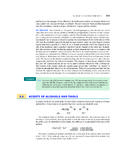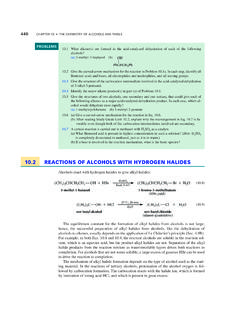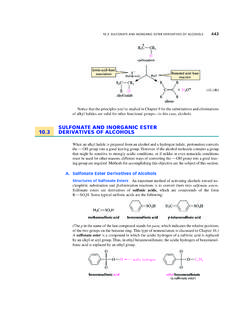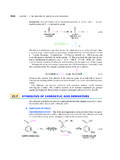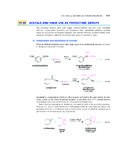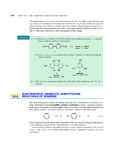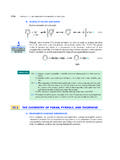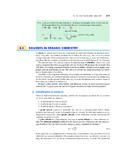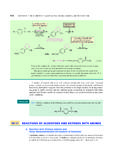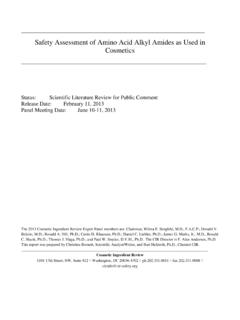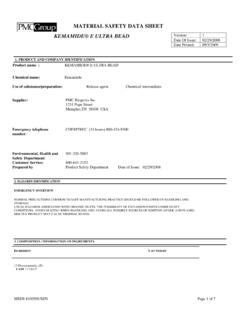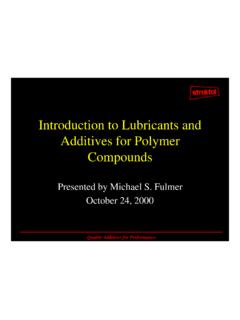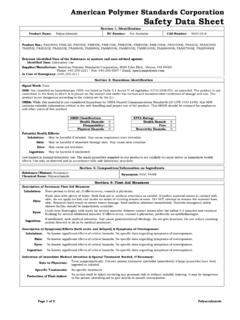Transcription of 21.9 REDUCTION OF CARBOXYLIC ACID DERIVATIVES
1 1022 CHAPTER 21 THE CHEMISTRY OF CARBOXYLIC acid the structure of the product in the reaction of each of the following esters with isotopi-cally labeled sodium hydroxide, Na| How would you synthesize each of the following compounds from an acid chloride?(a)(b) (c)(d) OF CARBOXYLIC acid DERIVATIVESA. REDUCTION of Esters to Primary AlcoholsLithium aluminum hydride reduces all CARBOXYLIC acid DERIVATIVES . REDUCTION of esters withthis reagent, like the REDUCTION of CARBOXYLIC acids, gives primary are formed in this reaction, one derived from theacyl groupof the ester (2-methyl-1-butanol in Eq. ), and one derived from the alkoxy group (ethanol in Eq. ).In most cases, a methyl or ethyl ester is used in this reaction, and the by-product methanol orethanol is discarded; the alcohol derived from the acyl portion of the ester is typically the prod-uct of noted several times (Sec.)
2 , the active nucleophile in LiAlH4reductions is the hy-dride ion(H3_) delivered from _AlH4, and this REDUCTION is no exception. Hydride replacesalkoxide at the carbonyl group of the ester to give an aldehyde. (Write the mechanism of thisreaction, another example of nucleophilic acyl substitution.)( )SLLLi|Li|_AlH4 AlH3C2H5O_OC2H5 RCOSLLHRCan aldehydeO+++( )SLLLLiAlH42 CH3CH2OC2H5 CHethyl 2-methylbutanoatelithiumaluminumhydrideC H3CO+H3O|ether"2-methyl-1-butanol(91% yield)ethanol++LL L2 CH3CH22C2H5 OHLi|, Al3| saltsCHOHCH2CH3"O(CH3)3 CLOSCH2 CLLOSOC(CH3)3 CLLLCOOOAH3 CCONO2 LLLLOSCH3 CHOSO2CH3 LLPh"SOOOLPhCH2 LLSSCH3 OPhCH2 LOSCH3 CLLABSTUDY GUIDE LINK 12/15/08 11:44 AM Page REDUCTION OF CARBOXYLIC acid DERIVATIVES1023 The aldehyde reacts rapidly with LiAlH4to give the alcohol after protonolysis (Sec.)
3 The REDUCTION of esters to alcohols thus involves a nucleophilic acyl substitutionreaction fol-lowed by a carbonyl borohydride (NaBH4), another useful hydride reducing agent, is much less reactivethan lithium aluminum hydride. It reduces aldehydes and ketones, but it reacts very sluggishlywith most esters; in fact, NaBH4can be used to reduce aldehydes and ketones selectively inthe presence of chlorides and anhydrides also react with LiAlH4to give primary alcohols. However,because acid chlorides and anhydrides are usually prepared from CARBOXYLIC acids, and becausecarboxylic acids themselves can be reduced to alcohols with LiAlH4(Sec. ), the reduc-tion of acid chlorides and anhydrides is seldom REDUCTION of Amides to AminesAmines are formed when amides are reduced with LiAlH4.
4 In the workup conditions, H3O|is followed by _OH. An aqueous acidic solution is often usedto carry out the protonolysis step that follows the LiAlH4reduction (as shown in the followingmechanism). The excess of acid that is typically used converts the amine, which is a base, intoits conjugate- acid ammonium ion. Hydroxide is then required to neutralize this ammoniumsalt and thus give the neutral water itself rather than acid can be used in the protonolysis step, for practical rea-sons the acidic workup is more convenient. Thus, the extra neutralization step is REDUCTION can be used not only to prepare primary amines from primary amides, butalso to prepare secondary and tertiary amines from secondary and tertiary amides, respec-tively.
5 ( )0LN(CH3)2 LiAlH4++1) H3O| 2) _OHLi|, Al3| saltsSLCO0LN(CH3)2 LCH2(88% yield)( )2 RCH2NH3conjugate-baseammonium ion(typical pKa = 8 11)amine(pKa = )H2 ORCH2NH2_OH+|+( )SLLLiAlH4NH22 Phlithiumaluminumhydridebenzamidebenzyla mine(80% yield)COLLNH21) H3O| 2) _OH2H22 PhCH2+++Li|, Al3| salts( )LLHRCOHHSLLHLiAlH4 RCOH3O|"" 12/15/08 11:44 AM Page 10231024 CHAPTER 21 THE CHEMISTRY OF CARBOXYLIC acid DERIVATIVESThe reaction of LiAlH4with an amide differs from its reaction with an ester. In the reduc-tion of an ester, the carboxylate oxygenis lost as a leaving group. If amide REDUCTION werestrictly analogous to ester REDUCTION , the nitrogen would be lost, and a primary alcohol wouldbe formed.
6 Instead, it is the carbonyl oxygenthat is lost in amide REDUCTION :Amide REDUCTION :Let s consider the reason for this difference, using as a case study the REDUCTION of a secondaryamide. (The mechanisms of REDUCTION of primary and tertiary amides are somewhat different,but they have the same result.)In the first step of the mechanism, the weakly acidic amide proton reacts with an equivalentof hydride, a strong base, to give hydrogen gas, AlH3, and the lithium salt of the lithium salt of the amide, a Lewis base, reacts with the Lewis acid resulting species is an active hydride reagent, conceptually much like LiAlH4, and it candeliver hydride to the CAN double _OLAlH2group is subsequently lost from the tetrahedral intermediate because it is less basic than the other possible leaving group.
7 The resulting product is an imine( ). ( )Al2"32 COHreactive hydrideHHNR2NR%%%#2""3 CHOLi|Li_AlH2%%%LLL( )2 AlH3_"332 COLi|NR%#2"32 COLi|NR%#LAlH3_( )S2332 LAlH3 AlH3H2__HHRCOLi|N++"%%%%S3322 COLi|NR%%332 COLi|_NR%#( )SLLNR!2 RCOLRCH2NR2the carbonyl oxygenis lostLiAlH41) H3O| 2) _OH( )SLLOR!RCOLH3O|RCH2 OHthe carbonyl oxygen is retainedR!OH+ 12/15/08 11:44 AM Page REDUCTION OF CARBOXYLIC acid DERIVATIVES1025 The CAN of the imine, like the CAO of an aldehyde, undergoes nucleophilic additionwith H3_ from _AlH4or from one of the other hydride-containing species in the reactionmixture. Addition of acid to the reaction mixture converts the addition intermediate into anamine by protonolysis and then into its conjugate- acid ammonium ammonium ion is neutralized to the free amine when _OH is added in a subsequent step(Eq.
8 C. REDUCTION of Nitriles to Primary AminesNitriles are reduced to primary amines by reaction with LiAlH4, followed by the usualprotonolysis in amide REDUCTION , isolation of the neutral amine requires addition of _OH at the conclu-sion of the mechanism of this reaction illustrates again how the C'N and CAO bonds react insimilar ways. This reaction probably occurs as two successive nucleophilic the second addition, the imine salt reacts in a similar manner with AlH3(or another equiv-alent of _AlH4).( )3 ALRCHLHAlH2 NAlH23 LLRCH2 NLi%%Li%Li%LLRCH2N|AlH2_#( )3A'LAlH3 RCLHAlH3_Li|N3 LRCHNL iimine salt+%"( )yLiAlH42++1) H3O| 2) _OHLi|, Al3| salts'CH2CN2-(1-cyclohexenyl)ethanenitri le2-(1-cyclohexenyl)ethanamine (74% yield)lithiumaluminumhydride%y2CH2CH2NH2 %( )3S2 LLCNRLi|_HLLHAl+H3O|H3O|""%%2 LLCHNRLi|_H""2 LLCHHNRH""LLCHH2 NRHLAl%%|( )32NR2""3 CHO223Li|Li|_AlH2%_2 NRLLCHH2 AlO+LLSan 12/15/08 11:44 AM Page 10251026 CHAPTER 21 THE CHEMISTRY OF CARBOXYLIC acid DERIVATIVESIn the resulting derivative, both the NLLi and the NLAl bonds are very polar, and thenitrogen has a great deal of anionic character.
9 Both bonds are susceptible to , an amine, and then an ammonium ion, is formed when aqueous acid is added to the re-action are also reduced to primary amines by catalytic hydrogenation using Raney nickel,a type of nickel aluminum intermediate in the reaction is the imine, which is not isolated but is hydrogenated to theamine product. (See also Problem , p. 1028.)The reductions discussed in this and the previous section allow the formation of the aminefunctional group from amides and nitriles, the nitrogen-containing CARBOXYLIC acid , any synthesis of a CARBOXYLIC acid can be used as part of an amine synthesis, but it isimportant to notice that the amine prepared by these methods must have the following form:As this diagram shows, the carbon of the carbonyl group or cyano group in the CARBOXYLIC acidderivative ends up as a LCH2 Lgroup adjacent to the amine Problem a synthesis of (cyclohexylmethyl)methylamine from cyclohexanecarboxylic CARBOXYLIC acid derivative used to prepare the amine must contain nitrogen.
10 The twosuch DERIVATIVES are amides and nitriles. However, the only type of amine that can be prepared di-rectly by nitrile REDUCTION is a primary amine of the form LCH2NH2. Because the desired productis not a primary amine, the REDUCTION of nitriles must be rejected as an approach to this acid (cyclohexylmethyl)methylamineOHCO%%S ?CH2 NHCH3%LCH2 RNLL$)CO or CN carbon ofthe CARBOXYLIC acid derivativeA'( )H2, catalystH2, catalystA'RCNL!RCHimineNH"LRCH2NH2LL( )'CH3(CH2)4 CCH3(CH2)4CH2NH22H2 Nhexanenitrile1-hexanamine+Raney Ni2000 psi120 130 C( )RCH2NH2LH3O|H3O|2 RCH2(neutralizationwith _OH givesthe amine)NH3|LLi|, Al3| salts+RCH2L%Al2"NLi%% 12/15/08 11:44 AM Page REDUCTION OF CARBOXYLIC acid DERIVATIVES1027 The amide that could be reduced to the desired amine is N-methylcyclohexanecarboxamide:This amide can be prepared, in turn, by reaction of the appropriate amine, in this case methy-lamine, with an acid chloride:Finally, the acid chloride is prepared from the CARBOXYLIC acid (Sec.
